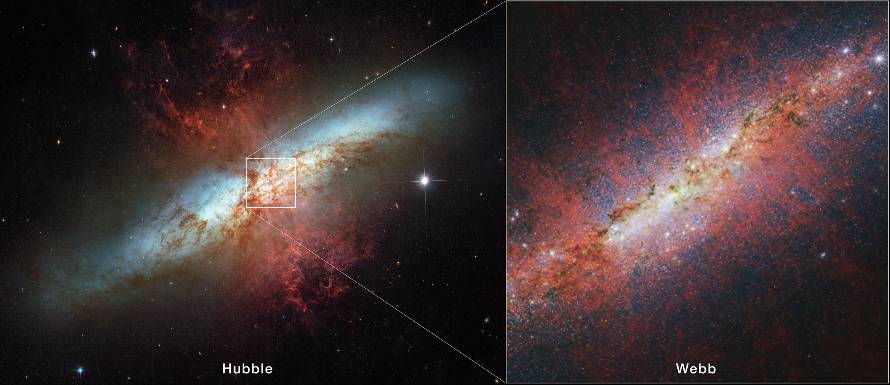NASA’s James Webb Space Telescope has provided astronomers with an unprecedented view of the starburst galaxy Messier 82 (M82), located 12 million light-years away in the constellation Ursa Major. The compact galaxy is forming stars at an astonishing rate, 10 times faster than our own Milky Way galaxy.
A team of astronomers, led by Alberto Bolatto from the University of Maryland, College Park, used Webb’s NIRCam (Near-Infrared Camera) instrument to survey the center of M82, where star formation is most active. The goal was to better understand the physical conditions that drive the birth of new stars.
“M82 has garnered a variety of observations over the years because it can be considered as the prototypical starburst galaxy,” said Bolatto, lead author of the study. “Both NASA’s Spitzer and Hubble space telescopes have observed this target. With Webb’s size and resolution, we can look at this star-forming galaxy and see all of this beautiful, new detail.”
Star formation is a mysterious process, as it is often hidden behind thick curtains of dust and gas. However, Webb’s ability to observe in the infrared allows astronomers to navigate these murky conditions and reveal previously unseen details.
The NIRCam images of M82’s center show a vibrant community of stars. While dark brown tendrils of heavy dust are still visible, even in the infrared view, Webb has revealed a level of detail that was previously obscured. Small green specks represent concentrated areas of iron, most of which are supernova remnants, while small red patches indicate regions where molecular hydrogen is being illuminated by nearby young stars.
“This image shows the power of Webb,” said Rebecca Levy, second author of the study at the University of Arizona, Tucson. “Every single white dot in this image is either a star or a star cluster. We can start to distinguish all of these tiny point sources, which enables us to acquire an accurate count of all the star clusters in this galaxy.”
When observing M82 at slightly longer infrared wavelengths, the team noticed clumpy red tendrils extending above and below the galaxy’s plane. These gaseous streamers are part of a galactic wind rushing out from the core of the starburst, caused by the rapid rate of star formation and subsequent supernovae.
The researchers were surprised to find that Webb’s view of the polycyclic aromatic hydrocarbons (PAHs) emission, which are very small dust grains that survive in cooler temperatures, highlights the galactic wind’s fine structure – a feature previously unknown. The PAH emission, depicted as red filaments, extends away from the central region where the heart of star formation is located.
“It was unexpected to see the PAH emission resemble ionized gas,” said Bolatto. “PAHs are not supposed to live very long when exposed to such a strong radiation field, so perhaps they are being replenished all the time. It challenges our theories and shows us that further investigation is required.”
The team plans to continue their research using additional data from Webb, including spectroscopic observations of M82 and complementary large-scale images of the galaxy and its wind. Spectral data will help astronomers determine accurate ages for the star clusters and provide insight into the duration of each phase of star formation in a starburst galaxy environment.
Studying galaxies like M82 can also deepen our understanding of the early universe. “Webb’s observation of M82, a target closer to us, is a reminder that the telescope excels at studying galaxies at all distances,” said Bolatto. “In addition to looking at young, high-redshift galaxies, we can look at targets closer to home to gather insight into the processes that are happening here – events that also occurred in the early universe.”
These findings have been accepted for publication in The Astrophysical Journal, and they showcase the incredible capabilities of the James Webb Space Telescope in solving mysteries across the cosmos.


